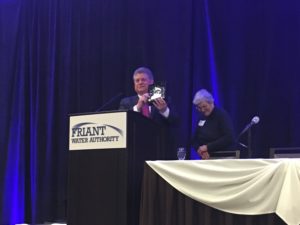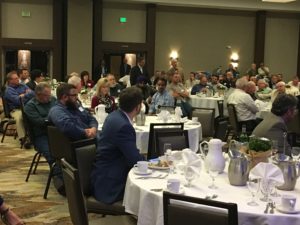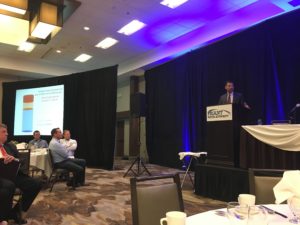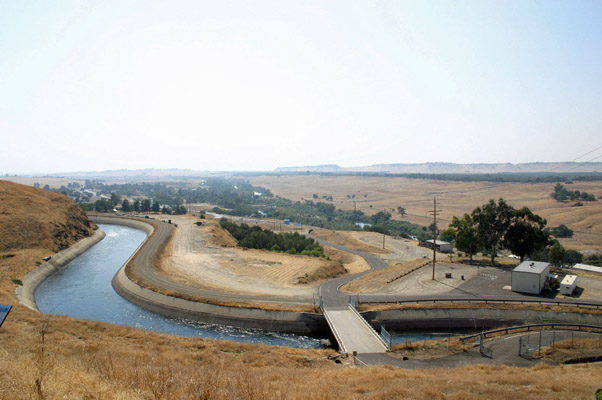The Friant Water Authority held its annual meeting on Tuesday, March 27, 2018 at the Fresno Convention Center. The event began in the late afternoon early evening but officially began at 6:00 pm. It was a mixture of fun, fellowship and serious consideration. I recognized people from all over the Valley representing if not all almost all of the various water interests from  the westside to Kern County as well as those served by Friant. Congressman David Valadao was there as well as Congressman Jim Costa. My estimate is more than 400 people showed up for the catered meal and most of them remained for the message. The food was good for banquet fare. The facilities laid out in a manner conducive to good communication; both amongst those sitting at the tables and the speakers at podium. One of the highlights of the meeting was the award to Saucelito Irrigation District Director Lucille Demetriff for her long service (1996-2017) to Friant. It was heartwarming to see FWA Chairman and Kern Tulare Water District Director Kent Stephens present Demetriff the award and recite the unique talents and accomplishments she brought to Friant.
the westside to Kern County as well as those served by Friant. Congressman David Valadao was there as well as Congressman Jim Costa. My estimate is more than 400 people showed up for the catered meal and most of them remained for the message. The food was good for banquet fare. The facilities laid out in a manner conducive to good communication; both amongst those sitting at the tables and the speakers at podium. One of the highlights of the meeting was the award to Saucelito Irrigation District Director Lucille Demetriff for her long service (1996-2017) to Friant. It was heartwarming to see FWA Chairman and Kern Tulare Water District Director Kent Stephens present Demetriff the award and recite the unique talents and accomplishments she brought to Friant.
FWA Chief Executive Officer Jason Phillips was charming and keep things moving along until the last third of the meeting. It moved along too and he stayed charming but the seriousness increased by the hour. Phillips gave the crowd a look at all Friant accomplished in 2017. It was impressive but so were the challenges he presented. Subsidence has left the Friant  Kern Canal’s ability to deliver water severally impacted. Half of the FKC’s capacity has been cut from land elevations collapsing in the area along the canal south of Porterville. As groundwater is pumped the land collapses and the canal can’t hold the water it was designed for.
Kern Canal’s ability to deliver water severally impacted. Half of the FKC’s capacity has been cut from land elevations collapsing in the area along the canal south of Porterville. As groundwater is pumped the land collapses and the canal can’t hold the water it was designed for.
But, that wasn’t the scariest message. FWA has taken a hard look at the Valley’s water future. The Friant Division of the federal Central Valley Project was designed as a conjunctive use project. It would take stored water from the Sierra Nevada snow pack run offs and irrigate crops. It was needed because groundwater pumping along the San Joaquin Valley’s eastside was causing subsidence. The irrigation by surface water would also recharge the aquifer which in turn would provide supplies for pumping during dry times. As laws and regulations reduced the surface supplies the price of water went up. As demand for the limited supplies increased crops that paid a higher profit replaced traditional row crops. The higher profit crops are trees and vines – permanent crops that require a steady, minimum supply of water. Flood irrigation was replaced by micro irrigation which helped tremendously in stretching supplies but does a poor job of recharging groundwater. So, once again the Valley’s east side is pumping more water. Please note it isn’t just the Valley’s eastside, everywhere in California where surface supplies have been reduced by man made legal and regulatory obstacles has had its groundwater negatively impacted.
A report compiled by FWA estimates the SJV uses 13.3 million a/f annually. That’s the total demand. Historically local supplies could account for 8.2 million a/f and the rest came from importing water from the San Joaquin River Delta. Supplies imported from the Delta and yields on the SJR have been cut over the years. Most of this lost water flows out to the ocean under the Golden Gate Bridge.
In 2014 the California legislature passed the Sustainable Groundwater Management Act – SGMA. SGMA will reduce how much groundwater pumping is allowed. Between the loss of surface supplies and restricted groundwater pumping the Valley may have to fallow or retired more than 270,000 acres of farmland. If Temperance Flat isn’t built that amount could be 1.5 million acres retired. In order to prevent this more surface storage, water banking, improved conveyance and steady supplies allocated and delivered will be needed.
Former Deputy Director of the state’s Department of Water Resources Dr. Jerry Meral spoke about the November  Water Bond of 2018. Of particular interest to Friant is the $750 million set aside to fund repairing the subsidence of the FKC and restore the design capacity of 4,000 cfs. The bond has lots of other attractive provisions like inland desalinization. The measure has enough votes to be on the November ballot but will need fundraising for the campaign itself. You can find out more at www.waterbond.org
Water Bond of 2018. Of particular interest to Friant is the $750 million set aside to fund repairing the subsidence of the FKC and restore the design capacity of 4,000 cfs. The bond has lots of other attractive provisions like inland desalinization. The measure has enough votes to be on the November ballot but will need fundraising for the campaign itself. You can find out more at www.waterbond.org
The last portion of the evening was a panel discussion by: Deputy Assistant Secretary for Water & Science in the US Department of Interior Austin Ewell, Regional Director of the US Bureau of Reclamation’s Mid-Pacific Region David Murillo and Director of the DWR Karla Nemeth. With Phillips moderating, the trio discussed:
- Raising Shasta Dam
- Biological re-consultations
- Transferring title of the FKC from the Bureau to FWA
- Governor Jerry Brown’s positions with President Donald Trump
It was interesting to hear Nemeth say Brown doesn’t resist Trump on water issues. I guess that means either Brown is in favor of raising Shasta Dam or at least in favor of having folks in his administration say he’s in favor. During questions Congressman Costa asked her how much of the California Water Fix she thinks can be achieved during the last days of the Brown term. Nemeth was pretty up beat saying the State Water Contractors are ready to move forward and the onus is now on the districts themselves.
Murillo believes getting real time monitoring in the Delta would be a great help in keeping the pumps running at their most efficient. Phillips and Ewell would like to work closer with DWR during the biological reconsultation. They see that as the first short term goal in helping fix the broken supply problems in California.
Director Edwin Camp, Arvin Edison Water Storage District closed the evening with a reminder that FWA is a public entity and therefore can’t engage in lobbying or political persuasion. However, the Friant Political Action Committee will able to take the voice of Friant to the politicians and policy makers. He urged those in attendance to support the Friant PAC.
It was a good evening, a good time for folks to hear the Friant message. Parts were very serious and parts were policy heavy as one would expect at a water board meeting. Some of the folks I was with not drenched in the minutia of federal asset transfers drifted a bit towards the end. All in all, I had a great time and enjoyed visiting with some many folks I only get to see in the formal settings of a traditional gaveled board meeting. Credit should be given to the Central Valley Group for the organizing the event. I look forward to next year’s annual meeting.
DISCLAIMER OF RESPONSIBILITY; Waterwrights strives to provide it’s clients with the most complete, up-to-date, and accurate information available. Nevertheless, Waterwrights does not serve as a guarantor of the accuracy or completeness of the information provided, and specifically disclaims any and all responsibility for information that is not accurate, up-to-date, or complete. Waterwrights’ clients therefore rely on the accuracy, completeness and timeliness of information from Waterwrights entirely at their own risk. The opinions expressed in this report are those of the author and do not represent any advertisers or third parties.
ALL RIGHTS RESERVED. Copyright 2018 by Don A. Wright No part of this publication may be reproduced, stored in a retrieval system, or transmitted in any form or by any means, electronic, mechanical, photocopying, recording, or otherwise, without the prior written permission of DAW.
FRIANT WATER AUTHORITY
854 N. Harvard Ave., Lindsay, CA 93247, Office 559/562-6305 Email:information@friantwater.org www.friantwater.org
The Friant Water Authority is a Joint Powers Agreement with 15 districts to operate and maintain the Friant Division of the Central Valley Project. Water from the San Joaquin River is diverted at Friant Dam at Millerton Lake to the Madera/Chowchilla Canal to the north and the Friant/Kern Canal to the south. More than one million acres of mostly family farms and numerous communities get their surface supplies from the Friant Division. Staff: CEO Jason Phillips, COO Doug DeFlitch, Superintendent Chris Hickernell and Attorney Don Davis.































